Warehouse Operations Best Practices: 55 Awesome Tips and Tactics to Improve Warehouse Management, Organization and Operations


Warehouse managers know all too well that the task of managing operations for a warehouse facility is far from straightforward. Warehouse operations managers are tasked with ensuring the efficient flow of products in and out of the facility, optimizing the building’s layout, making sure orders are fulfilled and products are in stock, but not overstocked. Add ensuring profitability and minimizing overhead and labor costs to the mix, and warehouse operators have their work cut out for them.
With so many factors to balance, considerations to weigh in every decision, and pressure from stakeholders on all sides to be more productive, minimize expenses, and maintain a smooth supply chain flow, it’s no surprise that there are many articles and resources outlining best practices for warehouse operations.
To make analyzing the vast array of information on warehouse operations best practices, we’ve put together a relatively concise list of best practices from a variety of sources. We’ve scoured the far corners of the web to identify these 51 best practices for warehouse operations to provide a useful resource for warehouse managers aiming to be top performers in their field and produce the best results possible for their companies. While categorized by topic, please note that the following best practices are not otherwise rated or ranked in any particular order of importance. To jump to a specific section, use the links in the table of contents below.
Table of Contents:

1. Use automatic data collection. “‘People writing numbers on pads of paper or keying strings of numbers into a keyboard is a bad sign,’ McKnight says.
The benefits of automatic data collection—via bar code and radio frequency identification—are well-established, including increased productivity and accuracy and lower labor costs. But plenty of companies still haven’t implemented automatic data collection.
‘Some organizations with 30,000 or 40,000 item numbers and multiple facilities are still convinced they’re better off without technology,’ McKnight says.” – Denny McKnight, partner, Tompkins Associates Inc., a supply chain integration firm headquartered in Raleigh, N.C., quoted by Leslie Hansen Harps in Best Practices in Today’s Distribution Center, InboundLogistics.com
2. Don’t rely on manual data entry processes. “INSTEAD: Use mobile computers with bar code scanners or RFID readers at the receiving dock to immediately identify products on arrival. This helps get product off the dock quickly and eliminates nearly all the errors associated with manual receiving: including identification, counting, and data entry errors. With scanning and RFID technology, you’ll avoid the mistakes that wreak havoc with inventory accuracy and eat up time and resources to fix. And that means your warehouse staff can focus on processing customer orders more quickly.” – Top 10 Losing Warehouse Strategies and How to Avoid Them, Motorola Solutions; Twitter: @MotoSolutions
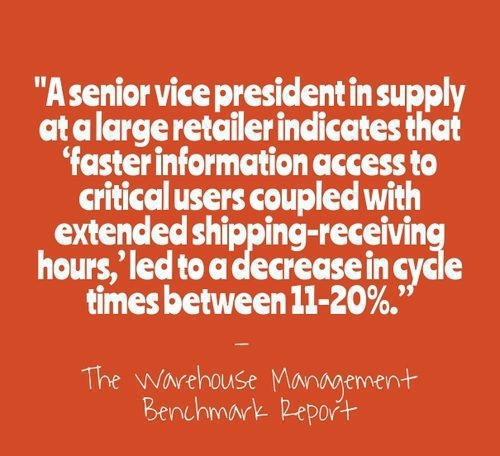
3. Promote information visibility company-wide. “The Best in Class point to an extensively proliferated warehouse visibility infrastructure that allows them to share information throughout their operation and across the company. Another respondent points to visibility as a means to improvement. A senior vice president in supply at a large retailer indicates that ‘faster information access to critical users coupled with extended shipping-receiving hours,’ led to a decrease in cycle times between 11-20%.” – The Warehouse Management Benchmark Report, Aberdeen Group; Twitter: @aberdeengroup
4. Asset tracking paired with a warehouse management system (WMS) provides the automation necessary to maximize warehouse productivity. “Smart businesses understand that controlling inventory, fulfillment and shipping costs is essential for success. Companies are constantly striving to improve their warehouse operations by increasing agility, visibility and labor efficiency. This requires use of best practices combined with a sophisticated Warehouse Management System (WMS) that optimally manages all resources within the distribution operations while minimizing the total cost of operation or ownership (TCO).” – Warehouse and Fulfillment: Streamline Your Fulfillment Process and Keep Your Customers Satisfied, NetSuite; Twitter: @NetSuite
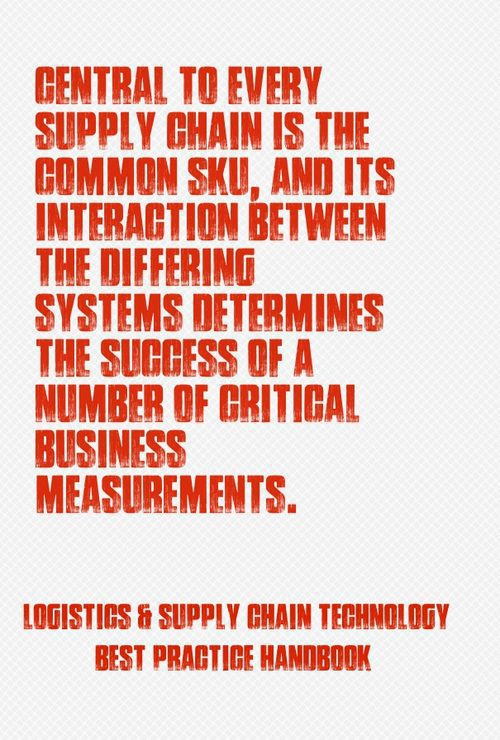
5. Data synchronization improves visibility and streamlines ordinarily labor-intensive data integration tasks. “Central to every supply chain is the common SKU, and its interaction between the differing systems determines the success of a number of critical business measurements. The key to harmonising data flow across complex suites of software applications in any size organisation is to synchronise all data that relates to the common SKU horizontally or vertically within the enterprise. This approach to standardising common product data at the system level and having no barriers to data transformation, is fast replacing labour intensive data integration tasks. The next evolutionary stage in the trade of data between organisations is where data repositories are updated with the very latest SKU information directly from suppliers. This transfer of interoperable data is now at a global and cost effective level, seamlessly upgrading inventory repositories, eliminating re-keying and reducing transcrepancies. It is set to become best practice where continuity of SKU information is essential for WMS, BOS, and POS investments. One source of data makes sense. The result – retailers, suppliers and consumers all become winners. With most companies aiming to eliminate returns and re-deliveries; reduce supply chain fines or chargeback’s; provide better invoice matching and stock holding, we might one day be talking about carbon
fingerprints rather than carbon footprints.” – Logistics & Supply Chain Technology Best Practice Handbook, BASDA; Twitter: @BASDAUK
6. Use bin locations to quickly locate products. “Are you using bin locations to locate your product? The vast majority of distribution software packages available today utilize bin locations. This allows for immediate, accurate location of products within your showroom and warehouse zones. Many distributors are leery of taking advantage of this tool because of the perceived need to keep vendor lines together. Bin locations, in fact, free you to locate product based on sales volume, thereby reducing the number of footsteps required to pick those key items that tend to show up on a majority of orders. I call this locating your product by velocity rank.
“Can you pass the ‘Temp Test’? Are you able to bring in a new hire or temporary employee and be confident that this individual is productive within two to three hours? Utilizing bin locations provides a map for the new recruit to follow. This allows you to look for someone skilled in the area of material handling. Without bin locations, you will need to look for someone who is experienced within the product lines you carry in order to find the product to fill orders. They will require more hand holding to learn where those different product lines are kept within your four walls.” – Dan Belanger, Do’s And Don’ts of Efficient (And Safe) Warehouse Operations, Gases and Welding Distributors Association (GAWDA); Twitter: @GasWeldEdge

7. Don’t mix multiple SKUs in a single bin location. “Mixing multiple SKUs in the same bin location reduces picking productivity. We have done time and motion studies that prove that there is a definite time penalty associated to mixing multiple SKUs into the same bin location.
“We see this in many warehouses where a bin location may represent a shelf level that contains 5 – 10 SKU pick facings. The operator is directed to the shelf level and then needs to search through the different SKUs to find the item to be picked.
“Not only does this reduce accuracy, it also slows the operator down by as much as 15+ seconds per pick transaction. Having a discrete pick location for every SKU is rule #1.” – Marc Wulfraat, President, MWPVL, 5 Ways to Improve Order Picking Productivity, SupplyChain247; Twitter: @SupplyChain247
8. Record the number of times inventory is picked during specific time frames using an asset tracking system. “There are times when it may not make sense to stock a product. As an example, if an item is picked only five times a year, the cost of storage can be eliminated by drop shipping from the manufacturer. By recording the number of times a product is picked, you can determine the value of the space where the inventory resides.” – Best Practices – Inventory Management, Promotion Fulfillment Center; Twitter: @PFCFulfillment
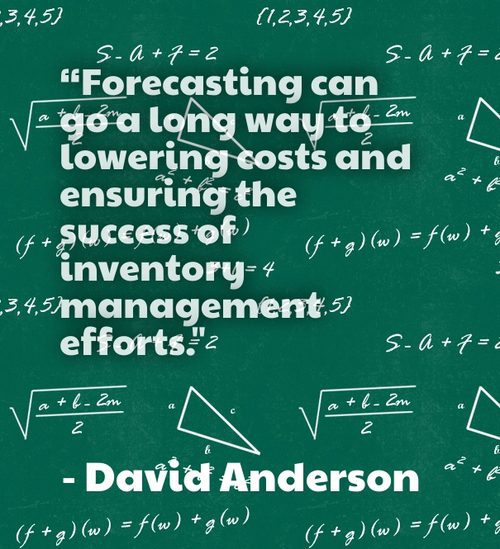
9. Asset tracking enables more accurate forecasting, essential for lowering costs and improving inventory management. “Forecasting can go a long way to lowering costs and ensuring the success of inventory management efforts. When retailers are able to accurately predict which items they need and the correct quantity, they will be better suited to meet the expectations of their customers without having surplus stock. Better forecasting requires deft observation of market research, market demand models, demand patterns, minimum stock levels and historical techniques and can play a huge role in successful inventory management.” – David Anderson, Three inventory management best practices, SalesWarp; Twitter: @SalesWarp

10. Use a unique tracking number, not the asset’s serial number. “It’s possible that an asset’s serial number will be identical to that of another asset. If the serial number is used as the tracking number, the duplicate numbers will cause confusion because there is no way to tell the two assets apart. This can compromise data integrity and lead to inaccurate customer balances and inventory, reduce your rental income and impact customer satisfaction. Using a unique tracking number different from the serial number eliminates these problems. In the rare event that a tracking number is lost, the asset still can be looked up using its serial number and re-labeled properly to retain the asset’s history.” – Christine Span, Top Five Asset Tracking Best Practices, TrackAbout; Twitter: @trackabout
11. Establish advanced shipping notification. “This may seem like a no-brainer, but many distribution centers still have not implemented electronically transmitted advanced shipping notifications (ASN). Relying on a “regular” shipping & receiving schedule can result in inefficiency throughout the distribution center. Delays happen, disruption happens- and it causes deviation from the “regular” schedule. The resulting issues start with improper staffing at the receiving dock and ripple through the warehouse. However, by leveraging electronic advanced shipping notifications within the purchase order and inventory management functions, labor can be planned with more certainty. Order fulfillment and transportation activities can be adjusted to ensure proper service time requirements are met, and transport modes are optimized to keep costs down.” – 11 Warehouse and Distribution Center Best Practices for Your Supply Chain, Legacy Supply Chain Services
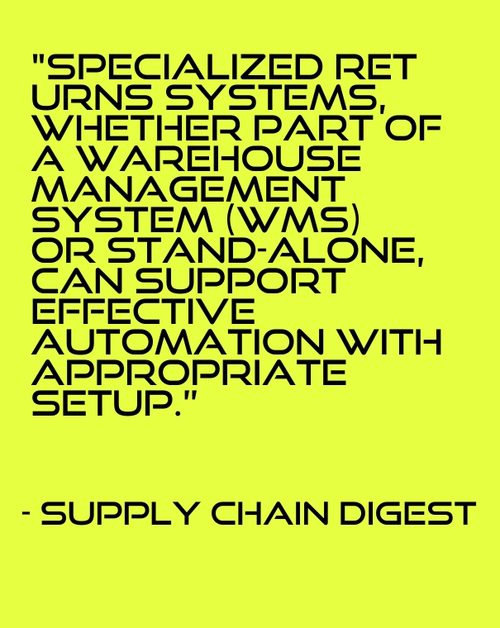
12. Implement an efficient returns process. “Returns are fundamentally complex because of how they impact physical inventory, electronic inventory and accounting systems. All items must be identified, assigned to a customer or account, assigned a disposition and then physically sorted for processing. Since some of the product might be discarded or kept back for vendor chargeback’s, not all merchandise enters electronic inventory; some merchandise must be repacked and accounted for manually versus electronically. Finally, credits are generally issued at a later time and often for only some part of a return, including discarded or un-saleable goods. This process is difficult to automate with a generic ERP package and very challenging with a simple paper process. Specialized returns systems, whether part of a Warehouse Management System (WMS) or stand-alone, can support effective automation with appropriate setup.” – Expert Insight: Best Practices in Warehouse Returns, Suppy Chain Digest; Twitter: @scdigest
13. Handle tasks efficiently and avoid procrastination. “Sometimes when you receive major shipments from suppliers, it’s easy to give it the ‘ol, “Eh. Let’s just take care of this later.” Put an end to the procrastination and take the time to breakdown the boxes, shove them in the recycling bin, un-package your products and stock them accordingly. This is a habit you must commit to. If your shipment comes around the same time each day/week, then schedule it on your calendar. Putting it off will only allow it to become an even larger beast, waiting for your attention.
“If you don’t have time to stock them on your shelves, another thing I used to do when working in retail was I’d take all the boxes and line them up. Open each one and see what is included. From there, make a mini stocking pile in each box. Knowing where they will eventually be housed, put close-proximity items together, so that you can then pull them to the correct spot on your warehouse floor and stock them quickly.” – Breena Fain, 6 Ways to Optimize Your Warehouse Management System, StitchLabs; Twitter: @StitchLabs
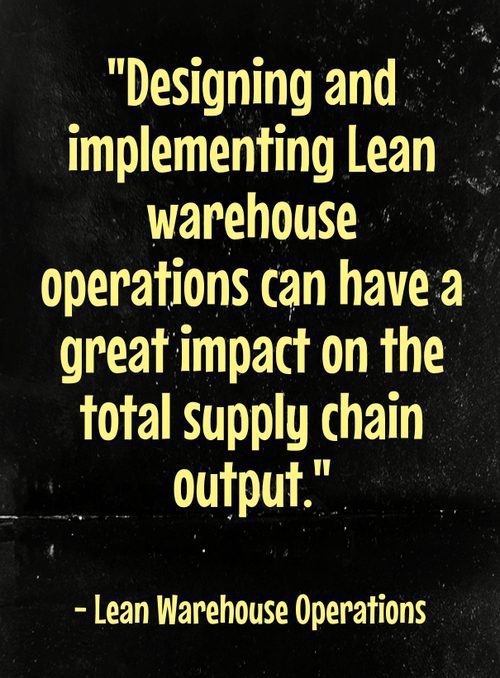
14. Implement lean warehouse operations practices. “Designing and implementing Lean warehouse operations can have a great impact on the total supply chain output. By approaching the waste focus areas mentioned above with Lean solutions, some of the opportunities that come up to reduce lead times in warehousing include:
15. Control inbound and outbound freight to reduce this area of cost. “Virtual libraries are being filled with articles on how to reduce or slow down this area of cost. It must be your number-one ongoing focus to prevent profit erosion. Use a consultant to help you competitively bid. While carrier agreements are proprietary, experienced consultants can still help identify areas to negotiate reductions without hurting service levels.” – Curt Barry, 10 Ways to Improve Warehouse Efficiency and Reduce Costs, Multi-Channel Merchant; Twitter: @mcmerchant
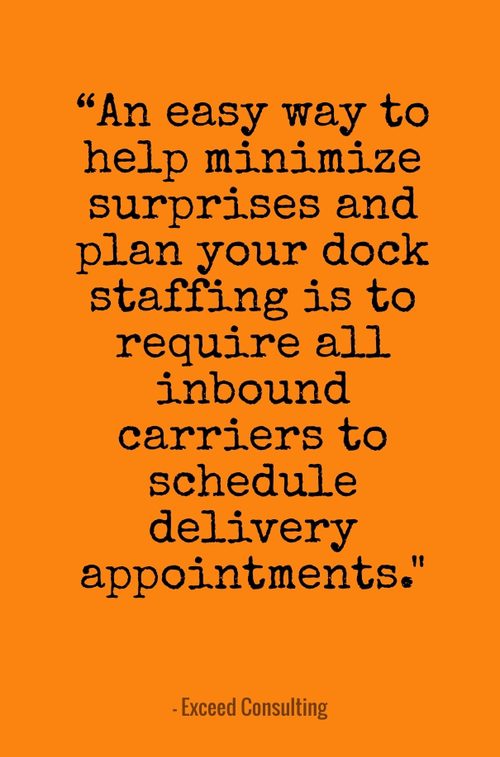
16. Require vendor receiving appointments. “An easy way to help minimize surprises and plan your dock staffing is to require all inbound carriers to schedule delivery appointments. There are two different methods to schedule and they can be used concurrently. The first method is to simply assign each carrier or delivery a specific time or window of time to deliver. The second is to assign either a specific or recurring daily, weekly, or monthly schedule to arrive. This allows you to schedule staff accordingly and make the best use of your dock. Vendor receiving appointments are absolutely critical if you share a dock or ship both inbound and outbound out of the same area. Any advance paperwork or data should be provided before the delivery is made. By requiring appointments and information about incoming loads, surprises are minimized.” – Back-to-Basics, Part 1: Receiving, Exceed Consulting
17. Conduct an ABC Analysis, which is helpful for categorizing your inventory by value. “ABC is a hierarchy of your most valuable items to the least (by dollar value). This is also referred to as the Inventory Categorization Method. Since you may not value your entire stock equally, this control will have you focusing your time and resources on items that make you the most money.
“A- items are big-ticket or priority stock. These goods require tighter controls and monitoring since they are your largest revenue and cost contributors. Due to their costs, you would most likely be carrying smaller volumes on hand. Since these items are heavily sought after, they should be stored under “lock and key”. In addition to security, A-list products will require higher frequencies of stock reviews and re-ordering. This ensures that you have adequate supply.
“Conversely, C-items have lower values but you may be carrying large volumes of them. For example, if you owned a hardware store, nails in bulk may be considered a C-item. B-items sit right in the middle for value, volume, frequency of stock reviews and re-orders.” – Colleen Rodericks, Inventory management techniques and best practices, inFlow; Twitter: @inFlowInventory
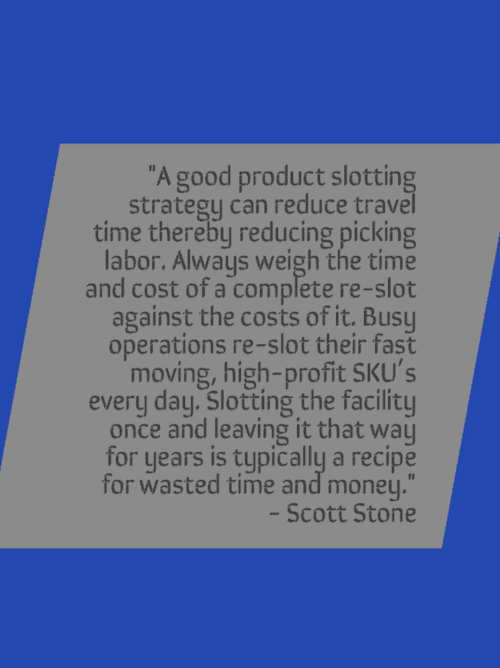
18. Re-slot your pick positions as often as necessary. “Up to 60% of a picker’s daily activity can be involved in travel time (afoot or on a forklift or walkie), so reducing that time-spend is an excellent idea. A good product slotting strategy can reduce travel time thereby reducing picking labor. Always weigh the time and cost of a complete re-slot against the costs of it. Busy operations re-slot their fast moving, high-profit SKU’s every day. Slotting the facility once and leaving it that way for years is typically a recipe for wasted time and money.” – Scott Stone, 13 Best Practice for Warehouse Productivity, Cisco-Eagle; Twitter: @CiscoEagle
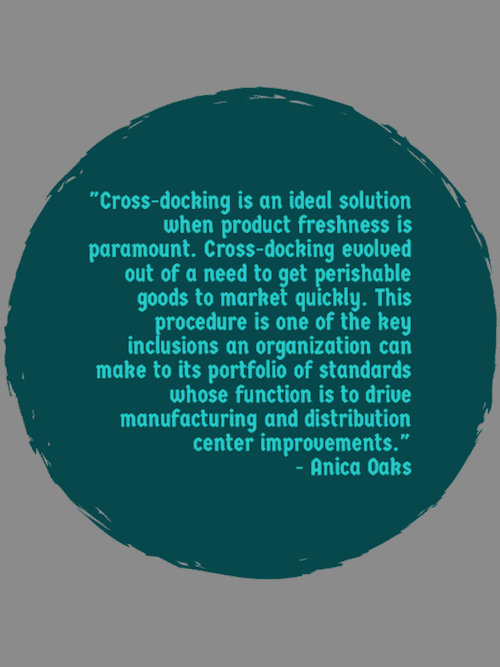
19. Utilize cross-docking wherever possible. “Superior logistics planning includes cross-docking wherever possible. Cross-docking is the practice of unloading materials from an incoming vehicle and immediately loading these same materials directly onto outbound vehicles with minimal or zero warehousing interval between. Think of this as “Just-in-Time” shipping. Cross-docking is an ideal solution when product freshness is paramount. Cross-docking evolved out of a need to get perishable goods to market quickly. This procedure is one of the key inclusions an organization can make to its portfolio of standards whose function is to drive manufacturing and distribution center improvements.” – Anica Oaks, 5 Lean Best Practices for the Warehouse, Apriso Manufacturing Transformation Blog; Twitter: @Apriso
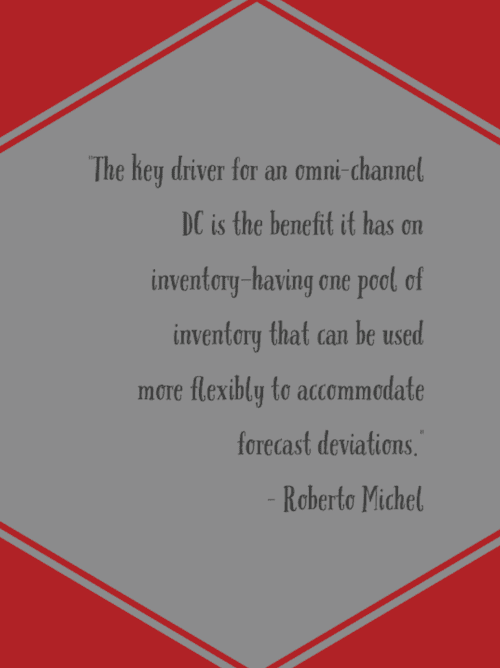
20. Create DCs that fulfill orders for multiple channels. “For some companies looking for omni-channel fulfillment efficiencies, the trend has been to move away from DCs dedicated to a single channel and instead have DCs that fulfill orders for multiple channels, says Ian Hobkirk, founder and managing director of Commonwealth Supply Chain Advisors.
“‘Ten years ago when e-commerce was still fairly new, you had a lot of channel separation in the way companies set up and run DCs, and e-commerce fulfillment, in many cases, was outsourced to a 3PL,’ says Hobkirk. ‘One of the trends we’re seeing now among retailers is to have multi-channel fulfillment centers in which inventory and fulfillment for all channels is under the same roof.’
“The key driver for an omni-channel DC is the benefit it has on inventory—having one pool of inventory that can be used more flexibly to accommodate forecast deviations. ‘There are other factors driving omni-channel fulfillment centers, such as the lower costs from being able to use a common pool of labor, but it’s the inventory factor that’s truly driving this trend,’ says Hobkirk.
“The rise of omni-channel fulfillment makes inventory management more complex, which elevates the need for better systems for execution, forecast collaboration, and management reporting, including warehouse management system (WMS), enterprise resource planning (ERP), as well as demand management and cross-disciplinary collaboration, says Don Derewecki, a senior consultant with supply chain advisory firm St. Onge Company.” – Roberto Michel, Warehouse/DC Management: Six Best Practices for Better Inventory Management, Logistics Management; Twitter: @LogisticsMgmt
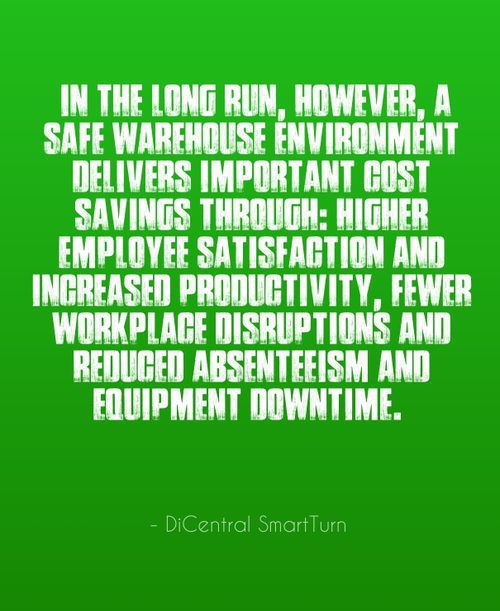
21. Make warehouse safety a top priority. “There is more to warehouse safety than compliance with fire codes and OSHA regulations. Unfortunately, too many warehouse and 3PLs look at safety as meeting the minimum mandated by law or their conscience. Often, neither goes far enough. In this chapter, we’re going to look at Best Practices for Warehouse Safety, discussing the benefits and risks to employees, managers and employers of both creating a culture of safety in the warehouse, and failing to do so. For those companies that fail to promote safety, it is often due to insufficient time, inadequate resources, or the opportunity to save money through corner cutting. In the long run, however, a safe warehouse environment delivers important cost savings through: higher employee satisfaction and increased productivity, fewer workplace disruptions and reduced absenteeism and equipment downtime. You can extend the life of your warehouse infrastructure such as storage and material handling equipment, as well as reduce damage to inventory. Most importantly, don’t assume that a safe workplace carries a jaw-dropping price tag.” – Inventory and Warehouse Management Best Practices, DiCentral SmartTurn; Twitter: @DiCentral_EDI
22. Form a safety committee. “Although not particularly severe, warehouse accidents are numerous—the warehousing and storage industry experiences nearly 15,000 injuries and illnesses each year, according to the U.S. Bureau of Labor Statistics.
“To keep a lid on accidents, warehouse operators should stress worker training and establish safety best practices, says Bob Shaunnessey, executive director of the Warehousing Education and Research Council (WERC), an Oak Brook, Ill.-based organization dedicated to warehouse management and its role in the supply chain.
“For most warehouses, forming a safety committee is the first step toward implementing enhanced safety procedures.
“A safety committee’s members are usually selected from specific organizational groups—including warehouse floor workers, shift supervisors, and department managers. This approach gives everyone a voice, but keeps the committee’s size to an effective number of participants.” – John Edwards, Warehouse Safety: It’s No Accident, Inbound Logistics; Twitter: @ILMagazine
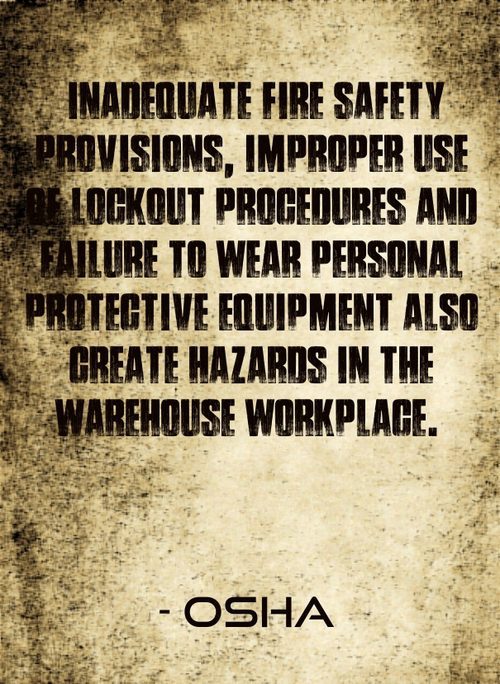
23. Have an emergency response plan in place. “Inadequate fire safety provisions, improper use of lockout procedures and failure to wear personal protective equipment also create hazards in the warehouse workplace. Employers should have an emergency plan that describes what is expected of employees in the event of an emergency, including:
• Provisions for emergency exit locations and
evacuation procedures;
• Procedures for accounting for all employees
and visitors;
• Location and use of fire extinguishers and
other emergency equipment.” – OSHA Pocket Guide, Worker Safety Series: Warehousing, OSHA.gov; Twitter: @usdol
24. Avoid common mishaps at loading docks and staging areas. “Loading docks or staging areas are common areas in a warehouse where injuries and damage to products occur. Common hazards include:
• Product falling onto employees’ head, feet, arms, and legs;
• Weak housekeeping programs that result in congestion;
• Employees jumping from a high elevation to a lower elevation;
• Lifting dock plates and constantly adjusting them; and
• Forklift or pallet jacks rolling off the dock.
“Controls include:
• Securing dock plates so they don’t roll over;
• Conducting daily inspections of loads and temporary storage
arrangements;
• Never allowing a forklift or pallet jack to back to the edge of the
dock;
• Enforcing safety rules about employee movement from higher dock
elevations to the lower ground surface; and
• Monitoring assigned safety inspection forms West Bend; Twitter: @WBsilverlining
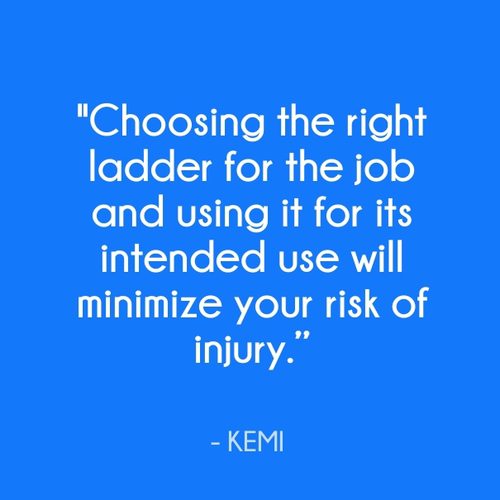
25. Provide appropriate ladders for the various jobs within your warehouse, and provide training so that workers can easily identify the most appropriate ladder for tasks. “Material handling is not the only potential source of injury within a warehouse. Items may have to be stacked so that space is used more effectively. Ladders may be used to reach the top of shelves or racks. Choosing the right ladder for the job and using it for its intended use will minimize your risk of injury.” – Warehouse Safety, KEMI
26. Clean up spills as soon as possible, and remove inventory and supplies from aisles when staff must vacate the area for a short time. “The warehouse is a place with lots of stuff. Its narrow aisles, tall stacks of goods, and poor lighting are the exact ingredients that can compromise visibility. Slipping and tripping over materials or spilled liquid are common accidents that can be avoided if the warehouse maintains adequate lighting and equips dark corners with special lights that can be easily switched on and off. Remove unnecessary steps or ridges and encourage employees to never leave any cargo, box, and goods unattended on the floor.
“If a warehouse worker needs to temporarily leave the floor, it is important for him or her to move materials away from the center of the aisle while keeping lights on. In cases when something is spilled, employees should take the proper steps to close the area with visible signs and clean up as soon as possible.” – Tom Reddon, 4 Ways to Avoid the Most Common Warehouse Incidents, Knowledge at Work

27. Only trained operators should use equipment such as forklifts, cranes, and hoists. “Forklifts and hand trucks aren’t the only warehouse equipment that can prove hazardous. Contact with moving conveyor parts can cause serious injuries. That’s why it’s so important to keep their guards in place. Cranes, hoists, and derricks can be operated only by trained operators who know enough to keep from swinging a load over people or to remove their hands or feet from controls while a load is suspended. In addition, anyone who works in the vicinity must pay attention to crane movements; if you work or stand under a crane, you’re looking for trouble. You may spot hazards in the way this equipment is loaded, too. Heavy or unbalanced loads could fall over and cause serious injuries—even fatal ones.” BLR.com; Twitter: @BLR_INC
28. Use sound storage practices to minimize the risk of fires. “The method of storage can affect the rate of fire spread and its severity for the same material. For example, paper reels stored vertically can give rise to stack effect. For indoor storage the suggested maximum height of pile is 4.5m. The clearance from top of pile to the lowest point of roof members, electrical fittings, or fire detectors should be a minimum of 1m. A colour band should be painted on the wall to indicate the maximum height to which materials can be stacked.” – N.V. Subba Rao and K. Ramish Ramalingham, Risk Management in Warehouses, Cholarisk.com
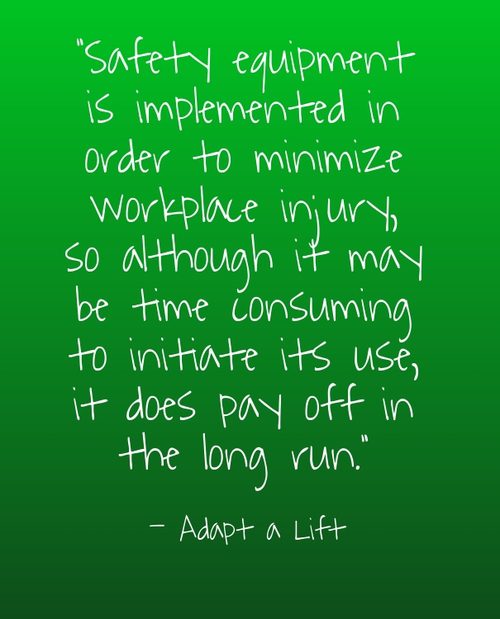
29. Safety equipment must be used at all times. “In the warehouse it is vital that forklifts or hydraulic dollies are used to lift items that are too heavy. Appropriate eyewear and hard hats should also be worn when required. Employees should be aware of emergency exits and the sprinklers installed in the roof should not be blocked at any time. Safety equipment is implemented in order to minimize workplace injury, so although it may be time consuming to initiate its use, it does pay off in the long run.” – Warehouse Safety Principles: 6 key guidelines to keep your workplace safe., AdaptALift; Twitter: @aalhyster
30. Post safety expectations in highly visible locations and key areas. “Warehouse supervisors should ensure all safety expectations are posted clearly in close proximity to all equipment—forklifts, hydraulic dollies, hand jacks, etc. Doing so assures that employees have constant visual reminders of the inherent dangers of using such equipment, and the safety precautions they should take to avoid injury.” – Warehouse Safety Checklist: 8 Things Every Manager Should Review, Legacy Supply Chain Services; Twitter: @legacyscs
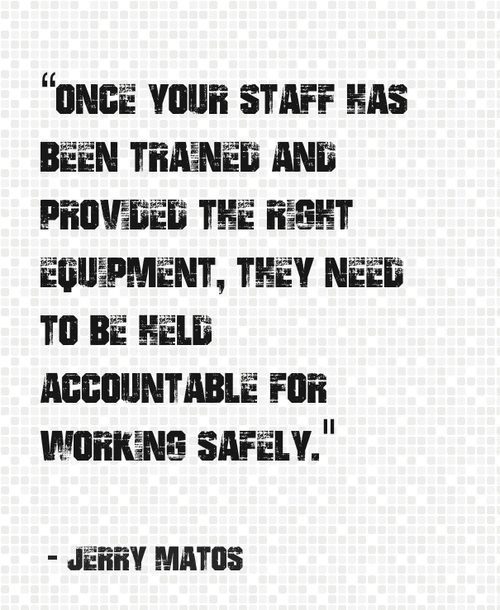
31. Establish accountability and give staff a sense of ownership over warehouse safety practices. “Once your staff has been trained and provided the right equipment, they need to be held accountable for working safely. This must apply to everyone in your warehouse. You cannot overlook bad habits of supervisors while reprimanding a dockworker. How you handle safety infractions is up to you, but your employees must own their actions. You will see better results if you offer suggestions for safer operation at the same time you express criticism.
“You do need to document lapses in safety. Without proper records, you may not have the backup you need to take action against an employee that continues to ignore your requirements. Documentation will also help protect you if an employee is injured performing an action after they have been instructed otherwise.” – Jerry Matos, Product Specialist, Cherry’s Industrial Equipment, 6 Ways To Encourage Warehouse Safety, Industrial Distribution; Twitter: @indistwebsite
32. Consider enlisting an outside expert to identify warehouse hazards. “To help improve the safety in the workplace, consider bringing in an outsider. The outsider does not necessarily need to be a consultant or OSHA representative, but may be a business associate, or peer. The point is to have a fresh pair of eyes evaluate the warehouse. Sometimes what is seen in plain sight every day may be an overlooked hazard.” – Best Practices for Warehouse Safety, Labor Law Center
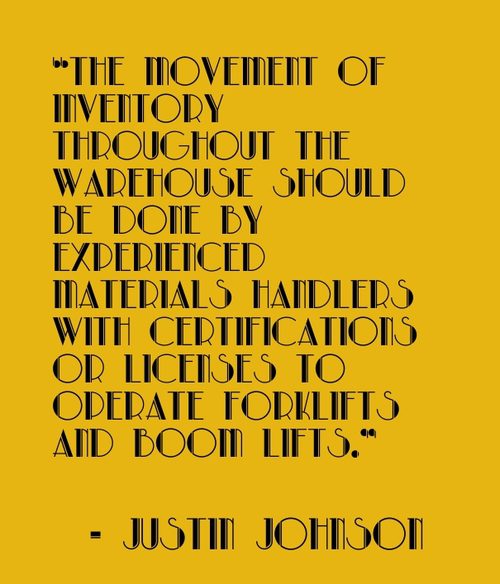
33. Clear aisles make for an efficient flow of inventory. “The movement of inventory throughout the warehouse should be done by experienced materials handlers with certifications or licenses to operate forklifts and boom lifts. These materials handlers should be able to move from one section of the warehouse to another with ease due to aisles that are not full of unstored inventory. Inventory that has not been placed in its proper bin or warehouse location can cause problems with inventory systems, especially under a FIFO, or First In, First Out, inventory system. A FIFO system ensures that the inventory that was received yesterday is moved to the shipping dock before the inventory that was received today. This inventory system reduces the chance of obsolete inventory sitting in warehouse bins.” – Justin Johnson, Best Practices in Warehouse Operations, Chron.com
34. Store the most frequently picked items close to the shipping area. “When considering the level of effort involved in warehouse operations, the greatest expenditure of effort is in the picking process. To gain efficiencies in picking the labor time to pick orders needs to be reduced and this can achieved in a number of ways. Companies with the most efficient warehouses have the most frequently picked items closest to the shipping areas to minimize picking time. These companies achieve their competitive advantage by constantly reviewing their sales data to ensure that the items are stored close to the shipping area are still the most frequently picked.” – Martin Murray, Supply Chain/Logistics Expert, Warehouse Best Practices, About.com

35. Implement efficient dock management practices. “Some of the most valuable square footage in the warehouse is dock space. All material must flow in and out of your docks, and these are limited in number (and not readily added to). Space on the inside and outside of the docks is some of the busiest in your warehouse. Dock best practice depends on the type of inbound you receive and for many companies balancing available dock doors, equipment, and labor is difficult, so the receiving dock becomes a choke point in the supply chain. Docks in today’s warehouses must be more flexible and must support a variety of receipts that are coming in at a faster rate and in greater frequency and with just in-time and VMI programs, smaller quantities and mixed pallets.” – Warehousing & Fulfillment Process Benchmark & Best Practice Guide, Warehouse Education and Research Council (WERC); Twitter: @WERC
36. Calculate resource and space requirements based on expected receipts and current backloads. “Put-away is the process of moving material from the dock and transporting it to a warehouse’s storage, replenishment, or pick area. Best-practice companies manage the put-away area by calculating resource and space requirements based on expected receipts and current backlogs. Best practice is to put away product the same day it’s received, because not doing so affects space, causes congestion, increases transaction errors, and makes product more susceptible to damage. In a busy warehouse, it is easy to let product put-away fall behind other tasks such as picking, replenishment, shipping, and loading. But pulling away resources from put-away tasks can affect fill rates by not having product in pick racks. This can bring about congestion in staging areas that overflow into aisles. Delaying put-away may also result in product damage as the merchandise is moved, again and again, to make way for higher priority receipts. Proper staffing of the put-away team will support down stream processes of picking and shipping, and in the long run lead to better customer order fill rates.” – Kate Vitasek, Best Practices in Material Handling and Put-away, Multi-Channel Merchant; Twitter: @mcmerchant
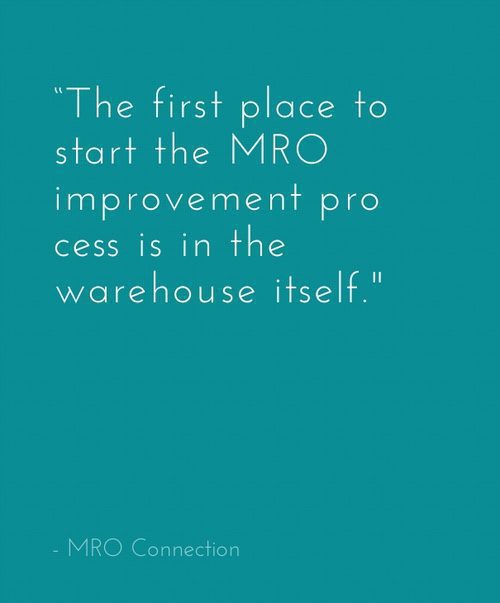
37. Establish stable warehouse operations within the warehouse first, then work to improve pre-planning efforts. “The first place to start the MRO improvement process is in the warehouse itself. Once stable warehouse operations have been established, maintenance and operations can work to improve their pre-planning efforts. At first glance, this appears to be a daunting task. Trying to organize, store, identify and properly manage thousands of disparate inventory items, with different and seemingly unpredictable demand patterns, creates an environment in which it is difficult to succeed. Creating an implementation strategy that is simple, straight forward and thorough, is critical to a successful MRO Warehouse Operation.” – Creating the “Perfect Warehouse,” MRO Connection
38. Maximize vertical space. “On the production floor, where space can be limited, it’s important to take advantage of every inch of available space (floor to ceiling). As noted in an Occupational Health & Safety article, solutions such as pallet racking can lead to safer working conditions as well as increased efficiency in the warehouse. Pallet racking, the most common way of storing pallet loads in the world, is an easy-to-use storage solution; it’s used in the vast majority of warehouses, manufacturing facilities, commercial warehouse operations, and even retail stores.” – Jennie Dannecker, 10 Ideas for More Efficient & Productive Warehouse Operations, Cerasis; Twitter: @Cerasis

39. Use your WMS software to sequence orders and organize the workflow. “Sequencing your orders by pick path, and batching together single lines, same-zone orders, and difficult picks – such as non-conveyable items – saves tremendous time on the distribution center floor. Again, your WMS software should be able to organize the workflow and optimize sequence performance.” – 10 Ideas for a More Efficient Warehouse Operation, ShelfPlus
40. Communicate effectively — and often. “Clearly communicating to workers your organizational goals and the processes to achieve them is one key to effective warehousing operations. When managers fail to create an environment of open and clear communication, employee productivity suffers, resulting in high turnover and wasted resources.” – Increasing Warehouse Productivity, Inbound Logistics; Twitter: @ILmagazine
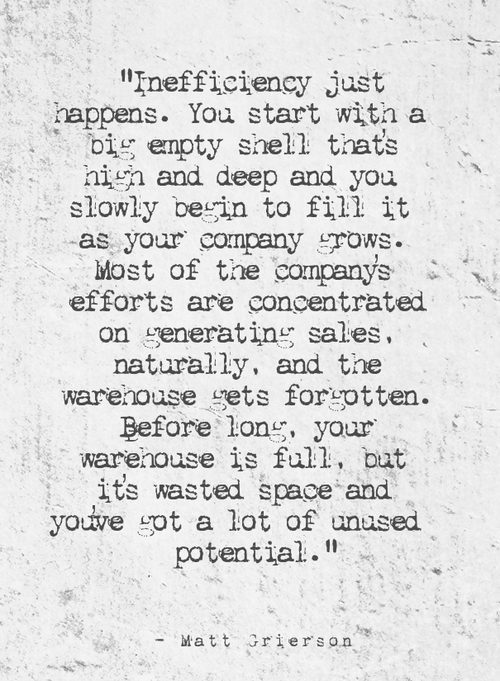
41. Make smart use of floor space. “Matt Grierson is managing director at Dexion, which provides industrial and commercial storage solutions across Europe. He says that only a small fraction of the companies that approach him believing they need to move into larger premises really do need to. The rest have enough space already, they’re just using it badly.
“Grierson says: ‘Inefficiency just happens. You start with a big empty shell that’s high and deep and you slowly begin to fill it as your company grows. Most of the company’s efforts are concentrated on generating sales, naturally, and the warehouse gets forgotten. Before long, your warehouse is full, but it’s wasted space and you’ve got a lot of unused potential.’
“By using your space efficiently, your staff can get jobs done quicker and can complete more jobs in a day, you save on purchase or rent by not expanding unnecessarily, and you can go longer before the huge burden of relocating into bigger premises.
“Grierson adds: ‘There are a lot of shelving options. Two-tier or mezzanine, fixed or mobile. If you can squeeze your rows of shelving together, and only open them up when access is required, you can save 50% of your floor space.'” – Tim Aldred, How to manage an effective warehouse, The Guardian; Twitter: @tim_aldred
42. Design storage systems to meet the needs of the current and planned mix of storage types. “The layout of a warehouse that supports an adjoining manufacturing facility will have different requirements than a facility supporting product distribution to stores or a facility that supports end-user fulfillment. Some operations place emphasis on replenishment of product to the point of use, others on product picking or order fulfillment.
“Regardless of the ultimate mission of the warehouse, best-practice companies have designed storage systems to meet the needs of the current and planned mix of storage types. They have optimized storage locations and layouts to fit product without the need to restack or repalletize it once received. The warehouse management system will track storage location profiles and properly assign product to the best storage location. As a result, best-practice companies have excellent cube-fill rates.
“In addition to optimizing the cubic fill of storage locations, best practice is to minimize travel time. If a product is in high demand it should be placed closer to its next point of use. In this case demand should be based on the number times the product is required, not on the number of units required. The difficulty of retrieval should also be considered in travel time. Higher-demand product should be placed on the most easily accessed storage space, typically floor level for racking and between waist and shoulder level in pick racks.” – Kate Vitasek, Storage and Inventory Control Best Practices, Multi-Channel Merchant; Twitter: @mcmerchant
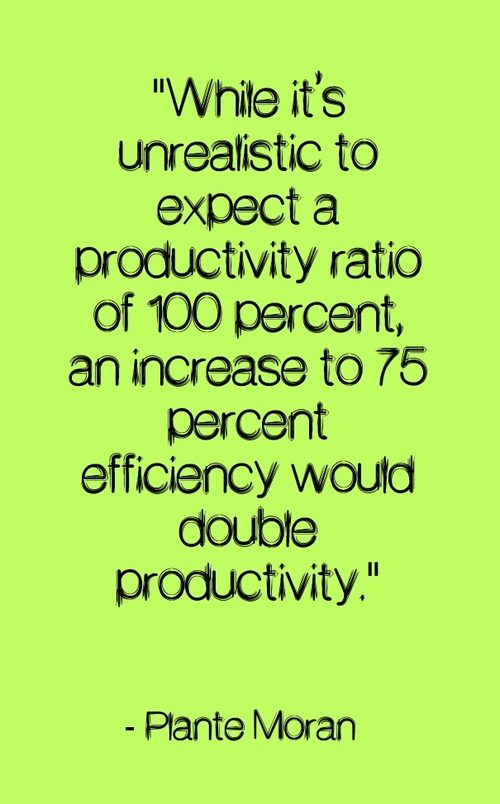
43. Reduce order processing cycle time. “In one analysis of a distribution operation, data revealed that the overall order processing cycle time was extremely inefficient. Of the total order cycle time, it was actually being worked on only 37.9 percent of the time. Six percent of the time was wasted while people dealt with problems such as waiting for lift equipment, computer issues, interruptions, and blocked aisles, and the remaining 56.1 percent of the time orders sat idle. This is a low productivity ratio by any standard. While it’s unrealistic to expect a productivity ratio of 100 percent, an increase to 75 percent efficiency would double productivity. How can this opportunity be captured? ” – Are Your Warehouse Operations Lean?, Plante Moran; Twitter: @PlanteMoran
44. Implement and maintain operational standards in all functional areas. “Maintain and use standards in all major functional areas. This will assist management in identifying systemic bottlenecks such as aisle congestion or other workflow problems.” – Warehouse Workflow Handbook, WERC; Twitter: @WERC

45. Improve cycle time utilization through lean applications. “Lean applications can help improve cycle time utilization, reduce costs, increase productivity, and increase customer satisfaction. To get to lean, begin with conducting a time study and analysis of the current order fulfillment process. Identify non-value added steps and note the amount of time spent on each of them. Then, assess overall workflow in an attempt to reveal inefficient product pick paths, wasted motion, excessive delays, excessive footsteps, aisle and work area congestion, and equipment availability.” – Chris Calderone, Creating a Lean HME Warehouse Operation, Lean Homecare; Twitter: @LeanHomecare
46. Reduce inventory inefficiencies. “Warehouse management systems are critical to tracking the various stages of the manufacturing process. From production to delivery, officials need to be able to monitor inventory as it makes its way through the supply chain. This is especially relevant during periods of growth, as a sudden influx of inventory may overwhelm employees on the floor, leading to costly errors. Without a robust inventory control system, managers may have difficulties locating materials or finished products, causing them to dedicate more manpower and resources to this process. Officials with Land Rover dealt with this issue on a regular basis, according to Zebra Technologies. When vehicles rolled off the assembly line, they were subject to a number of finalization processes, including testing, setting configurations and addressing any existing errors. Managers had a great deal of difficulty identifying where individual items were located along the supply chain, resulting in a high degree of uncertainty and risk.” – Nancy Master, Identifying Warehouse Management Best Practices, RFgen; Twitter: @RFgenSoftware

47. SKU profiling can facilitate profitability. “Understanding how every SKU carried in your distribution center (DC) can – and should – contribute to your company’s bottom line – is the best way to design and run DC operations. Here’s why: Each SKU has a potential cost impact that goes well beyond its actual purchase price. The decisions surrounding whether a SKU should be stocked and where, and in what status it is to be held in the supply chain, impact the profitability of your company. And from a selfish standpoint, these same decisions, made without sufficient evaluation, can rob your distribution center of capacity and efficiency.” FORTE Industries
48. Establish minimum holding stocks to cover lead times. “It has been established that the role of inventory management is to ensure that stock is available to meet the needs of the beneficiaries as and when required.
“Inventory represents a large cost to the humanitarian supply chain. This is made up of the cost of the inventory itself, plus the cost of transporting the goods, cost of managing the goods (labor, fumigation, repackaging, etc) and keeping the goods in warehouses. The inventory manager’s job is to make inventory available at the lowest possible cost.
“In order to achieve this, the inventory manager must ensure a balance between supply and demand by establishing minimum holding stocks to cover lead-times. To achieve this, the inventory manager must constantly liaise with the programs to keep abreast of changing needs and priorities. The warehouse must always have sufficient stocks to cover the lead-time for replacement stocks to avoid stock-outs.” – Warehousing and Inventory Management, Logistics Cluster; Twitter: @logcluster

49. Perform cycle counts and analyze discrepancies. “Don’t wait until the annual physical inventory count comes to perform regular inventory control audits. Perform cycle counts and analyze their discrepancies to perfect the time it should take you to go through all locations. It’s good to have cycle counts go through all locations every quarter so that you have a more accurate back-office system.” – Andy Eastes, CEO of Agile Harbor, 10 Ways to improve warehouse efficiency and inventory management without software, SKUVault; Twitter: @skuvault
50. Develop an approved stock list for each location. “When you stock an item you are making a commitment—a commitment that the product will be available in reasonable quantities for immediate shipment or delivery to customers. Most distributors’ warehouses are filled with two things: ‘stock’ and ‘stuff.’ Stock is the material you intend to be in the warehouse. That is, the items necessary to meet or exceed customers’ expectations of product availability. Stuff is everything else. You must separate the stock from the stuff in each of your warehouses. Our goal is to liquidate the stuff and arrange the stock items in such a way to minimize the cost of filling customer orders.” – John Schreibfeder, President of Effective Inventory Management, Inc., The First Step to Achieving Effective Inventory Control, via Lanham Associates; Twitter: @LanhamAssoc
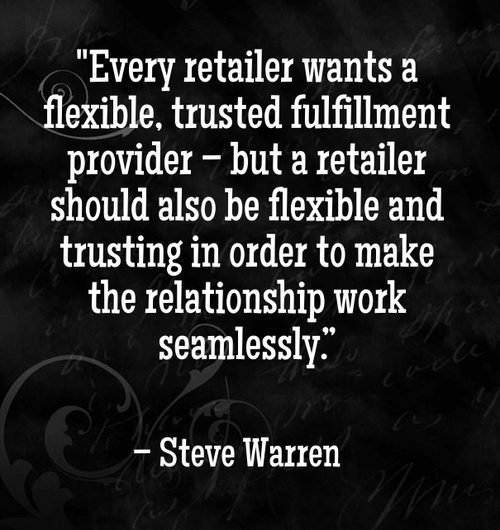
51. Maintain constant, consistent communication with vendors. “A good relationship with your vendors is crucial to your company’s success – especially if you outsource any part of your retail operations. Your fulfillment provider becomes your brand in the eyes of the customer, so it’s important that they understand your plans for your inventory as well as you do.
“This means constant communication of your promotional plans, product information, and upcoming releases. Every retailer wants a flexible, trusted fulfillment provider – but a retailer should also be flexible and trusting in order to make the relationship work seamlessly.” – Steve Warren, 4 Tips for Effective Inventory Management, Multi-Channel Merchant; Twitter: @mcmerchant
52. Achieve inventory analysis efficiency. “With solid inventory analysis, you can ensure that you are investing in the right amount of the right products to remain competitive. By developing and using a comprehensive set of tools to closely monitor the performance of your inventory, you can achieve more of your goals more efficiently.” – Bill Knapp, Socius, Beyond Software: 6 Effective Inventory Management Practices, featured on the ERP Software Blog; Twitter: @erpsoftwareblog and @mssocius
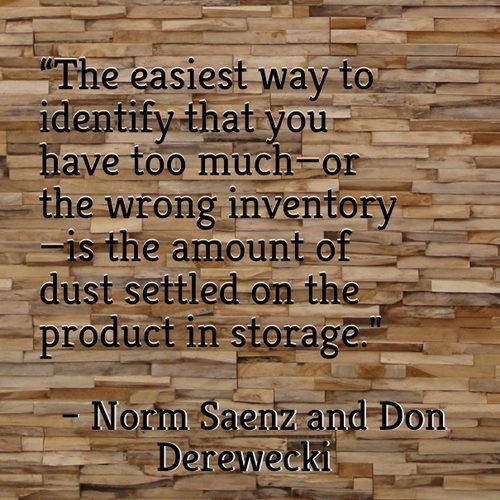
53. Understand the warning signals. “The easiest way to identify that you have too much—or the wrong inventory—is the amount of dust settled on the product in storage. If you see more than ½ inch of dust, then that’s likely a sign of obsolete inventory. However, there are other, more specific indicators that inventory management issues need to be addressed.
“If there are significant discrepancies between the book inventory and physical inventory, this is a direct indicator that there is a problem with inventory management. Another distinct indicator is when your warehouse staff is having trouble locating inventory on a timely basis—an issue that’s particularly critical when FIFO, batch/lot number or serial number controls are involved.
“The issue of locating specific inventory is typically tied to inventory discrepancies. And, of course, if you’ve seen a trend in the increased use of outside storage space, then this can indicate another ongoing inventory management issue.” – Norm Saenz and Don Derewecki of St. Onge, Inventory Management 101: Time to revisit the principles, Logistics Management; Twitter: @LogisticsMgmt
54. Use both fixed and moveable tracking options. “When companies think of warehouse tracking, they think primarily of movable tracking options, tracking the units and pallets that actually get moved around the warehouse and sent up the supply chain. This is only one part of the warehouse management process – do not forget the benefits that come with used fixed trackers, too! By tracking fixed warehouse assets, you are able to assign and manage destinations much more easily, and arrange strategy protocols as needed without mass confusion. It is better to think of warehouse tracking in two different parts, one fixed and one movable.” – Justin Velthoen, 7 Tips for Warehouse Inventory Management, QStock Inventory; Twitter: @QStockInventory
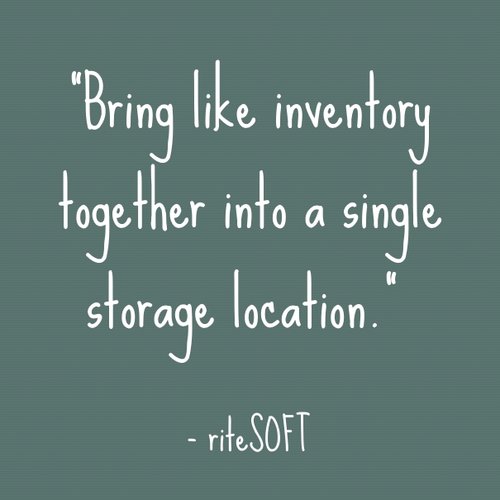
55. For physical count inventory, keep like inventory together in a single location. “Bring like inventory together into a single storage location. The same part shouldn’t be in several storage areas unless physical size dictates a limitation. In that case, keep available quantities to a minimum and move remainder to a location that isn’t part of the easily accessible storage (overstock location).” – Warehouse Management Tips for Physical Count Inventory, riteSOFT; Twitter: @ritesoft
Our sales engineers are experts in automatic asset tracking, tagging and identification,a nd can answer all your questions. Get in touch now.
Lets Talk ›